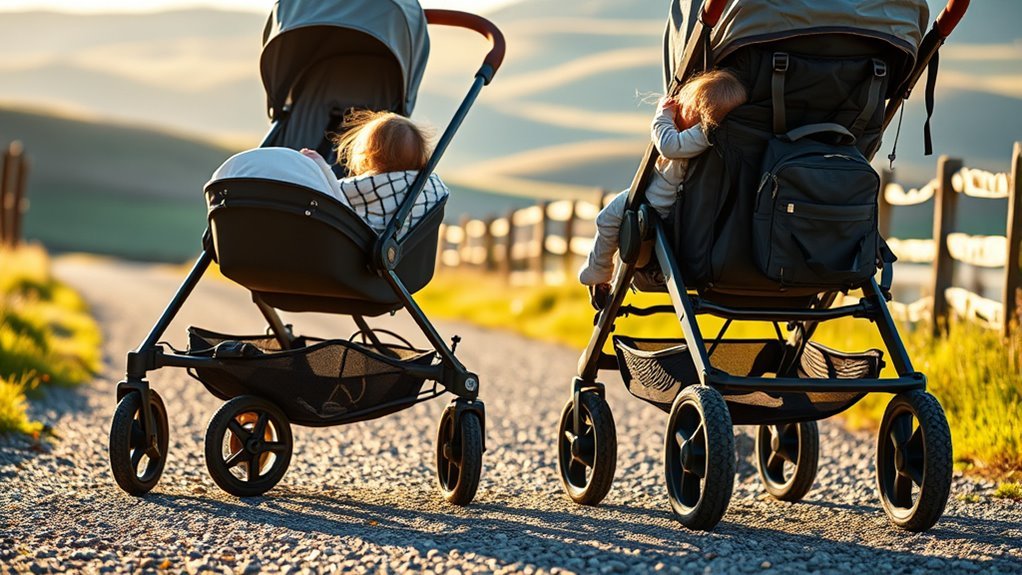By coincidence, we just tested five double strollers on the same gravel path and were surprised by how different the rides felt. We’ll walk you through models that balance suspension, maneuverability, and durability so you can pick what fits your family. Expect clear pros and cons for each stroller and practical notes on which terrains they handle best — keep going to find the one that’ll make rough paths much easier.
Chicco Cortina Together Double Stroller – Minerale | Black/Silver
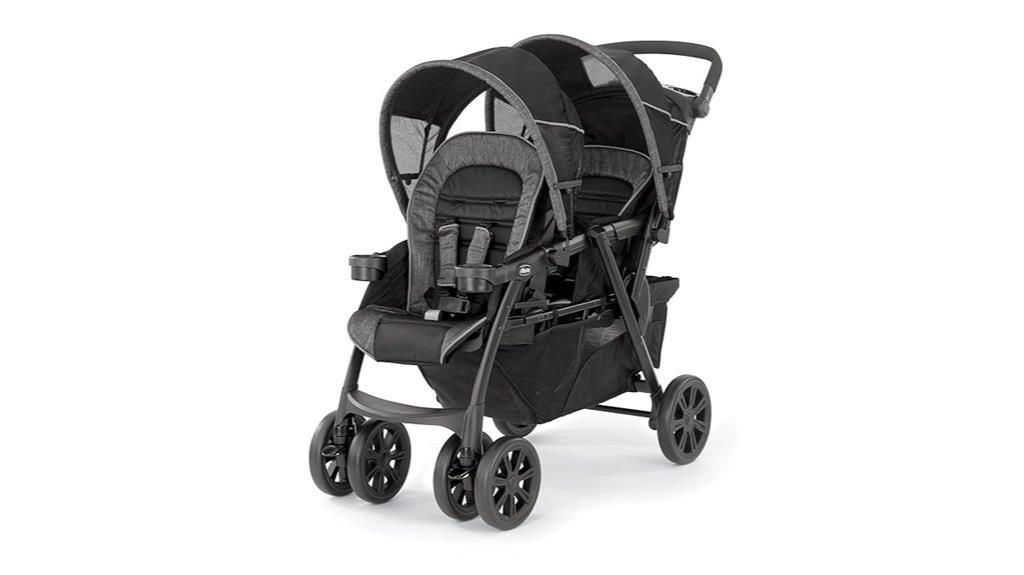
If you need a tandem stroller that handles rough paths without overcomplicating life, the Chicco Cortina Together Double is a solid pick — its all-wheel suspension and flat-free EVA tires smooth out gravel while the one-hand self-standing fold keeps setup and storage quick for busy parents. You’ll appreciate compatibility with any two Chicco infant car seats—no adapters—plus two reclining seats with independent canopies and multi-position full recline for naps. A padded handle, parent tray, oversized basket with rear zip access, and toe-tap brakes add practicality. At 34 pounds and a 40-pound max per seat, it balances durability and maneuverability.
Best For: Parents of newborns and toddlers who need a sturdy, tandem stroller that handles rough paths while offering easy folding and compatibility with two Chicco infant car seats.
Pros:
- Accepts any two Chicco infant car seats with click-in attachment (no adapters needed), simplifying travel with infants.
- All-wheel suspension and flat-free EVA tires provide a smoother ride on gravel and uneven surfaces.
- One-hand self-standing fold, oversized basket with rear zip access, and parent tray with cup holders enhance everyday convenience.
Cons:
- Heavier than many single strollers at 34 pounds, which may be cumbersome for lifting or tight spaces.
- Folded dimensions are still relatively large, potentially limiting storage in small cars or compact homes.
- Maximum weight recommendation of 40 pounds per seat may limit use as children grow larger.
Graco DuoGlider Double Stroller (Tandem, Glacier)
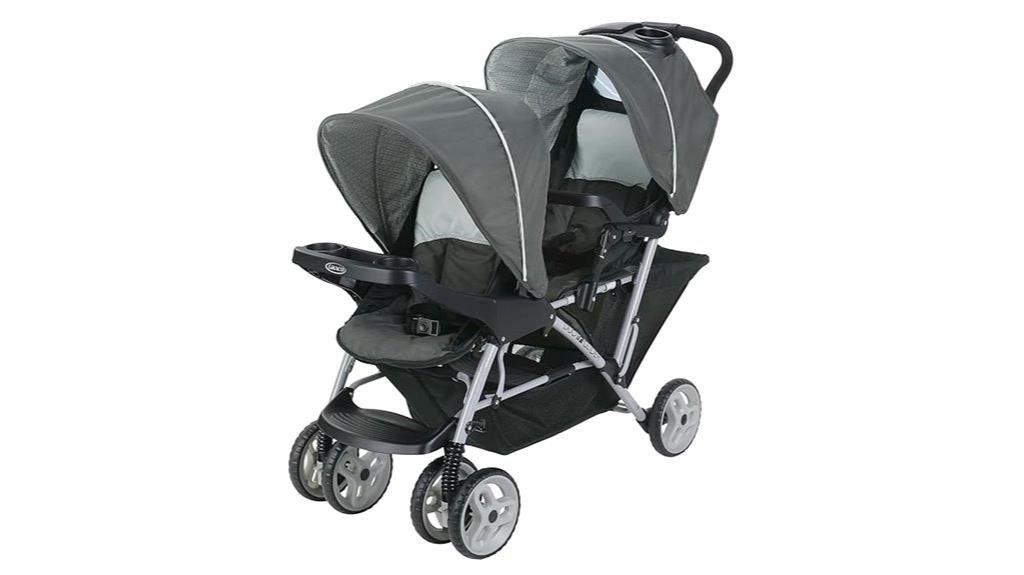
The Graco DuoGlider is a solid pick for parents who need a lightweight tandem stroller that still handles uneven surfaces, since its lockable swivel front wheels with suspension and rubber tires help smooth out gravel and rough sidewalks. You’ll appreciate stadium-style seating that raises the rear child for a better view, two reclining seats with individual canopies, and child trays with cup holders. It accepts two Graco SnugRide infant car seats (not convertible types), folds one-handed to stand for storage, and offers an extra-large basket plus a parents tray with deep cups. At 29.5 lb, it supports 40 lb per seat.
Best For: Parents who need a lightweight, budget-friendly tandem stroller that maneuvers well on uneven sidewalks and accommodates two infants/toddlers (up to 40 lb each) with room for accessories.
Pros:
- Lightweight tandem design with lockable swivel front wheels and suspension for smoother rides on rough surfaces.
- Stadium-style reclining seats, individual canopies, child trays with cup holders, and a large storage basket plus parents tray.
- One-hand standing fold and compatibility with two Graco SnugRide infant car seats for travel-system convenience.
Cons:
- Not compatible with convertible, 3-in-1, or 4-in-1 car seats (only Graco SnugRide infant car seats).
- Relatively narrow features for larger families—each seat maxes at 40 lb and overall stroller is basic compared with higher-end doubles.
- Fabric care requires delicate washing/line drying and frame maintenance may need occasional oiling for squeaky wheels.
Baby Trend Snap-N-Go® Double Stroller
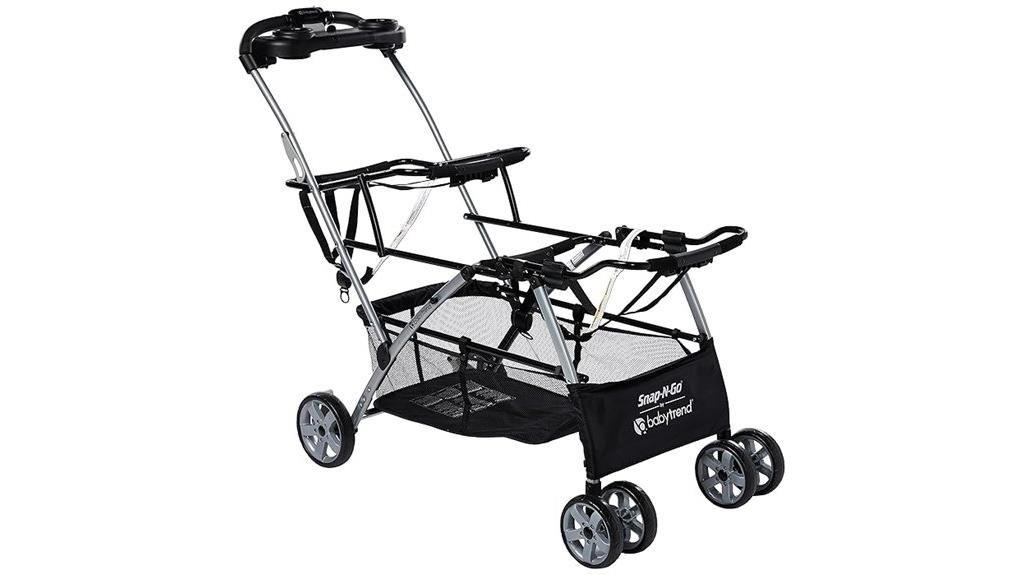
Parents who need a lightweight, car-seat-compatible double stroller for mixed surfaces will appreciate the Baby Trend Snap-N-Go® Double Stroller, which accepts most major infant car seats and keeps your little ones secure with a 5-point harness and rear-wheel brakes. You’ll like its 18-pound frame, quick one-hand fold, and compact dimensions for trunk storage. Seven-inch front and eight-inch rear wheels handle packed gravel and sidewalk shifts better than tiny casters. The extra-large basket, parent tray with two cup holders, and covered compartment add practical storage. It supports up to 90 pounds combined, carries two seats, and comes with a one-year warranty.
Best For: Parents who want a lightweight, car-seat-compatible double stroller that handles mixed surfaces and stores compactly for travel and everyday outings.
Pros:
- Accepts most major infant car seats for easy newborn-to-stroller transitions.
- Lightweight 18-pound frame with one-hand quick fold and compact dimensions for trunk storage.
- Larger 7″ front and 8″ rear wheels, extra-large storage basket, and parent tray with two cup holders for practical convenience.
Cons:
- Not compatible with Baby Trend Snap Fit or Snap Gear car seat models.
- Limited to a combined 90-pound weight capacity, which may restrict use as children grow.
- Basic suspension and materials (polyester/metal/plastic) may not be as plush or durable as higher-end strollers.
Baby Trend Sit N’ Stand® Double 2.0 Stroller, Dash Black
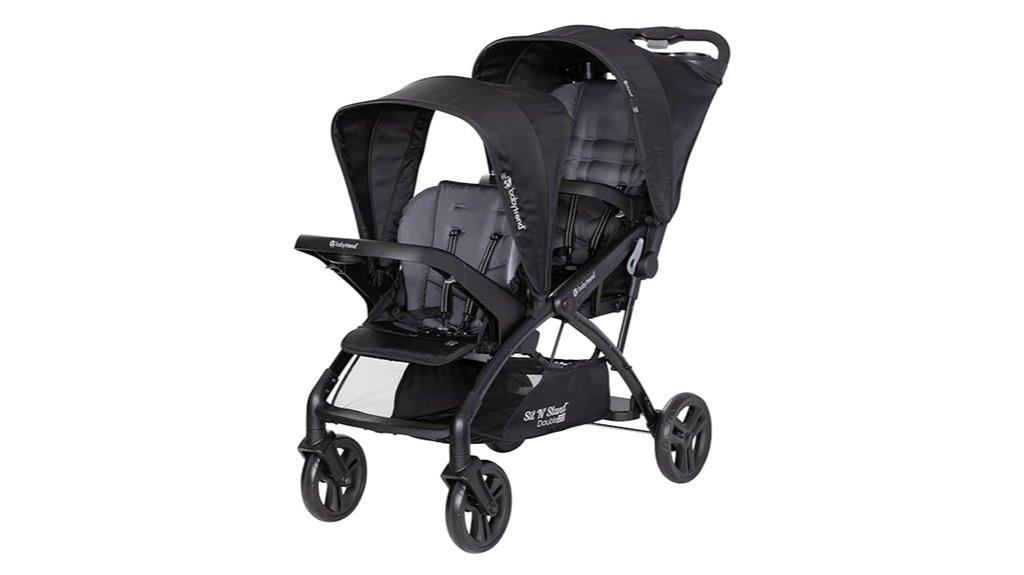
For caregivers who need a versatile, family-friendly option on mixed terrain, the Baby Trend Sit N’ Stand Double 2.0 stands out with its rear platform and dual seating that handle a toddler and infant without crowding. You’ll appreciate the tandem layout, compatible with Baby Trend EZ-Lift and Secure-Lift car seats, and the 5-point harnesses that secure both riders. The front seat’s removable two-panel ratcheting canopy plus a fixed rear canopy keep sun off little ones on gravel paths. A one-hand fold, extra-large basket, parent console with cup holders, and ASTM/JPMA compliance make this Dash Black stroller practical and reliable.
Best For: Caregivers needing a versatile tandem stroller that accommodates an infant and toddler on mixed terrain while offering easy fold and car-seat compatibility.
Pros:
- Spacious tandem design with rear stand-on platform and dual seats for flexible seating arrangements.
- Compatible with Baby Trend EZ-Lift and Secure-Lift infant car seats and includes 5-point harnesses for safety.
- One-hand fold, extra-large storage basket, and parent console with cup holders for convenience on the go.
Cons:
- At 15.15 kg (33.4 lbs) and sizable dimensions, it may be heavy and bulky for some caregivers to lift or store.
- Rear canopy is fixed (with visors) rather than fully adjustable, offering less sun/shade flexibility for the back seat.
- Maximum weight per seat/overall limits (4–50 lbs) may restrict use as children grow, requiring an upgrade sooner.
Thule Urban Glide 3 Double, Black
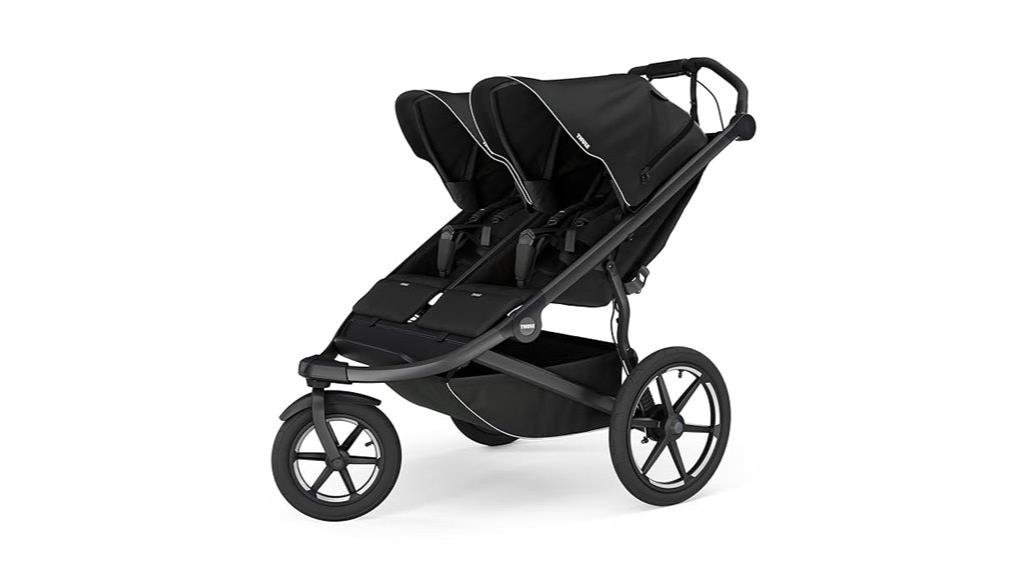
If you need a rugged, fast double stroller that handles gravel without fuss, the Thule Urban Glide 3 Double is built for joggers and active families who won’t compromise on maneuverability or speed. You’ll appreciate the 16-inch off-road wheels, suspension, and front-wheel lock for steady high-speed runs. The aluminum frame and one-hand compact fold make transport and storage simple, while the integrated twist hand brake gives precise speed control. It fits two children up to 49 pounds each, accepts infant gear with adapters, and offers a large ventilated canopy, 5-point harnesses, cup holders, and a limited lifetime warranty.
Best For: Active parents and families who want a fast, maneuverable double jogging stroller that handles off-road terrain while still folding compactly for transport.
Pros:
- Rugged 16-inch off-road wheels with suspension and front-wheel lock for stable high-speed runs.
- One-hand compact fold with self-stand and lightweight aluminum frame for easy transport and storage.
- Accommodates two children up to 49 lbs each, includes large ventilated canopy, 5-point harnesses, cup holders, and integrated twist hand brake.
Cons:
- Requires separately sold adapters to use infant car seats and a bassinet for newborn use.
- At 35.3 pounds (bassinet weight stated) and large dimensions, it may be bulky for smaller vehicles or tight storage spaces.
- Premium features and build may come with a higher price compared with basic double strollers.
Factors to Consider When Choosing a Double Stroller for Gravel Roads
Let’s look at the key factors that make a double stroller handle gravel well: wheel size and type, suspension quality, tire material and tread, weight and maneuverability, and frame strength. We’ll explain how larger, air-filled or foam-filled wheels and a robust suspension absorb bumps and improve control. Then we’ll cover how tire tread, overall weight, and a sturdy frame affect stability, steering, and long-term durability.
Wheel Size and Type
Although gravel can be unpredictable, choosing the right wheel size and type makes a huge difference in how smoothly we can push a double stroller. We prefer larger wheels — around 16 inches — because they roll over ruts and loose stones with less effort and improved stability. Pair those wheels with off-road tires that have a rugged tread pattern to maximize traction and control on uneven surfaces. Swivel front wheels that lock are a must: they let us maneuver tight spots but stay straight on rough stretches. Keep weight in mind — lighter models are easier to push but may feel less sturdy, while heavier, purpose-built strollers resist bouncing and track better on gravel.
Suspension System Quality
After choosing large, lockable wheels and rugged tires, we should look at the stroller’s suspension system because it has the biggest impact on how well the rig smooths out gravel bumps. We want a high-quality system that absorbs shocks so children ride comfortably and we don’t get jostled. Prefer all-wheel suspension for enhanced stability and consistent damping across uneven surfaces; it reduces the jarring effects when one wheel drops or hits a rut. Larger-wheel models often pair with more capable suspensions, so wheel choice and suspension go hand in hand. A well-designed suspension also improves maneuverability, letting us steer around rocks and roots with less effort. Prioritize smooth, reliable travel over gimmicks when evaluating suspension quality.
Tire Material and Tread
Tire choice matters most when we’re pushing a double stroller over gravel: rubber or EVA compounds give better grip and hold up longer on rough surfaces, while flat-free options cut the risk of punctures. We should prioritize deeper tread patterns for traction and stability, since shallow treads let loose stones shift under the wheels. Bigger wheel diameters smooth out bumps and roll over uneven ground more easily, so we favor models with larger off-road wheels. All-wheel suspension complements good tires by absorbing shocks and reducing jostle for both children and the person pushing. Together, durable tire material, aggressive tread, and compatible suspension deliver predictable handling and consistent performance on gravel paths, minimizing maintenance and improving ride comfort.
Weight and Maneuverability
When we’re choosing a double stroller for gravel roads, weight and maneuverability should be top priorities because they directly affect how easily we push, steer, and control the stroller over uneven surfaces. We prefer lighter models because they reduce push effort and fatigue, but we also watch weight distribution; a lower center of gravity improves balance and helps prevent tipping on rough ground. Design features matter: all-wheel suspension smooths bumps and keeps wheels in contact with the surface, while larger off-road tires give better traction and help roll over stones. We evaluate overall width and turning radius, since narrower frames and responsive steering let us make sharp turns on tight gravel paths without sacrificing stability or comfort for either child.
Frame Strength and Build
Durability matters: we want a frame made from strong materials like aluminum or reinforced polymer that can take the repeated shocks and twists of gravel without flexing or failing. We look for solid build quality that keeps the stroller stable when the terrain gets uneven, since extra stress concentrates at weak points. Proper weight distribution is essential — a well-engineered frame balances two kids to reduce tipping risk on rough paths. Higher frame strength usually means a better weight capacity, so we can carry older children or extra gear safely. Don’t overlook reinforced joints and sturdy wheel attachments; they’re where failures start. In short, choose frames with proven materials, thoughtful engineering, and visible reinforcements for long-lasting performance on gravel roads.
Seat Comfort and Recline
Comfort on gravel starts with seats that recline and cushion well, because bumps amplify every jolt for little bodies. We recommend multi-position recline so infants can lie flatter when paths get rough and older kids can sit up to enjoy the view. Padded seats matter: extra cushioning soaks up vibration and prevents little spines from tiring on longer rides. Independent reclining backrests are a must for double strollers — each child can set their own angle without disturbing the other. Full-recline capability is especially important for babies who need proper posture and restful naps over uneven terrain. Finally, don’t forget secure, well-fitted harnesses; a stable seating position keeps kids safe and comfortable when gravel makes the ride bouncy.
Storage and Balance
Because gravel adds unpredictability, we focus on storage and balance as much as suspension and seats: a roomy basket lets us carry extra water, snacks, and safety gear without shifting weight into the wheels, while a lower center of gravity and wider wheelbase keep the stroller steady over ruts and rocks. We prioritize models with large, accessible baskets so essentials stay secure and don’t pull on the handlebar. Evenly distributed weight prevents sudden tipping when one wheel drops into a hole. All-wheel suspension complements balance by smoothing impacts and keeping tires planted. We also inspect frame geometry and wheel spacing—small differences change handling on loose surfaces. Together, thoughtful storage placement and deliberate weight distribution make gravel outings safer and less fatiguing.
Folding and Transport
When we’re out on gravel roads, a stroller that folds quickly and compactly makes shifts far easier, so prioritize one-hand folding and a self-standing fold that lets you set it down without juggling kids or gear. We look for compact folded dimensions so the stroller fits tight trunks and narrow storage spots. Lightweight models save our shoulders when we lift them into cars or carry them over uneven ground. A self-standing fold adds convenience during quick stops or when loading gear. Always check the folded size and weight against your typical transport needs — frequent travelers need smaller, lighter packs. Together, these features make bringing a double stroller on rough paths far more practical and keep outings smooth from start to finish.
Frequently Asked Questions
Can Double Strollers Fold Easily With One Hand While Carrying Gear?
Yes — many double strollers fold easily with one hand while carrying gear; we look for models with one‑hand fold mechanisms, wrist straps or quick‑release baskets, and lightweight frames so you can secure items and fold quickly.
Are Any of These Models Compatible With Car Seats From Other Brands?
Yes — some models accept car seats from other brands via universal or brand-specific adapters; we’ll check compatibility lists and use approved adapters only, since mixing manufacturers without verification can risk safety and void warranties, so proceed cautiously.
Which Stroller Has the Best Resale Value After Heavy Outdoor Use?
We think the BOB Revolution Duo holds the best resale value after heavy outdoor use; buyers trust its durable frame, proven suspension, and brand reputation, so we’d expect stronger demand and higher resale prices than competitors.
Do Any Models Offer Built-In Phone or GPS Mounting Options?
Yes — some models include built‑in phone or GPS mounts. We’ll point out brands like Thule and Bugaboo that offer integrated or accessory mounts, and we’ll recommend checking compatibility before buying or attaching accessories.
Are Replacement Parts and Service Centers Widely Available Nationally?
Want to know if parts and service are widespread? We’d say generally yes: major brands offer national parts networks and authorized service centers, but indie makers may not, so we recommend checking coverage before you buy.
Conclusion
We’ve taken each stroller down the rocky lane, felt the bumps, and pictured kids giggling as pebbles scatter — but one choice still stands out for your family’s ride. Whether you crave sleek speed, rugged durability, compact convenience, or flexible seating, we’ve mapped the strengths so you don’t have to. Now imagine the perfect outing: smooth momentum, satisfied little ones, and a stroller that makes every gravel path an invitation rather than an obstacle.
